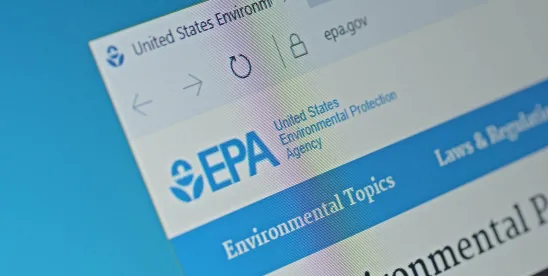The U.S. Environmental Protection Agency (EPA) announced a comprehensive set of actions to address per- and polyfluoroalkyl substances (PFAS) contamination on April 28, 2025, with a focus on preventing PFAS from entering drinking water systems, holding polluters accountable, and protecting passive receivers. According to EPA Administrator Lee Zeldin, this announcement represents the initial phase of a strategy aimed at tackling PFAS contamination throughout the Trump Administration. Despite the announcement’s emphasis on enforcement, significant questions remain regarding the EPA’s commitment to existing core PFAS regulation.
EPA Announcement in Context
During the Biden administration, EPA launched several significant initiatives to combat PFAS contamination, recognizing the chemicals’ persistence in the environment and harmful health effects. Key efforts included the 2021 “PFAS Roadmap,” which outlined a strategy for research, regulation, and cleanup, as well as the implementation of new reporting requirements under the Toxic Substances Control Act (TSCA) in 2024.[1] These rules mandated that companies disclose details about PFAS manufacturing, use, and disposal dating back to 2011. Additional actions under the Emergency Planning and Community Right-to-Know Act (EPCRA) expanded annual PFAS reporting requirements to include lower concentration thresholds, while a separate rule designated two PFAS chemicals as hazardous under CERCLA, prioritizing them for cleanup and enforcement.[2]
Although the tone of EPA’s most recent announcement suggests the new administration will build upon these initiatives, it notably omits a commitment to maintaining or defending several of the core regulations previously adopted. Nevertheless, the announcement did outline a new set of actions that sheds light on EPA’s evolving strategy for addressing PFAS.
Key Actions
The EPA announcement outlined a multi-pronged strategy to strengthen scientific understanding, fulfill statutory obligations, and build partnerships to address PFAS contamination. Below are some of the key actions:
- Strengthening the Science: To enhance scientific coordination, the agency will appoint a dedicated PFAS lead, implement a testing strategy under TSCA, expand data collection on air emissions, and begin annually updating its PFAS Destruction and Disposal Guidance. EPA also plans to accelerate method development to close key measurement and data gaps.
- Fulfilling Statutory Obligations and Enhancing Communication: To meet statutory mandates and improve communication, the EPA will propose new effluent limitations for PFAS manufacturers and metal finishers, explore enhanced enforcement through RCRA, and continue implementing the Safe Drinking Water Act and TSCA to prevent further contamination. The agency also announced a commitment to updating the Toxic Release Inventory (TRI) and addressing compliance issues, while working with Congress and industry to create a liability framework that protects passive receivers.
- Building Partnerships: Finally, the EPA emphasized collaboration with states and tribes to support cleanup, risk assessment, and enforcement, and pledged to finalize its biosolids risk assessment based on public input.
Takeaways and Looking Forward
EPA’s announcement suggests that the Trump administration is advancing actions that align with the general goals established during the Biden administration, and will not be rolling back federal restrictions on PFAS entirely. In announcing this plan, EPA Administrator Zeldin stated that this would be “the first, not the last” Trump administration decision regarding PFAS.
Consistent with this statement, on May 13, 2025, EPA published an interim rule extending the deadline for PFAS reporting requirements under TSCA Section 8(a)(7) and announced that it would be reviewing the regulation in light of Executive Order 14219.[3] In addition, on May 14, 2025, EPA announced that it would rescind drinking water regulations that limit certain PFAS in drinking water, and will extend the compliance period for others. EPA has not announced any action with respect to PFAS listed as hazardous substances subject to federal remediation requirements, but has stepped back from its defense of those regulations against industry challenges.[4]
Entities likely to be affected by PFAS regulation, or that are currently subject to reporting requirements or use restrictions, should closely monitor federal as well as state actions and decisions related to PFAS.
FOOTNOTES
[1] PFAS Strategic Roadmap: EPA’s Commitments to Action 2021—2024; TSCA Section 8(a)(7) Reporting and Recordkeeping Requirements for Perfluoroalkyl and Polyfluoroalkyl Substances | US EPA
[2] Addition of Certain PFAS to the TRI by the National Defense Authorization Act | US EPA; Designation of Perfluorooctanoic Acid (PFOA) and Perfluorooctanesulfonic Acid (PFOS) as CERCLA Hazardous Substances | US EPA
[3] Trump Executive Orders Tracker | Sheppard Mullin
[4] See discussion of Chamber of Commerce of the United States of America, et al., v. U.S. Environmental Protection Agency et al., Case No. 24-1193 (D.C. Cir.) in Sheppard’s Environmental YIR: 2024 Regulatory Legacies and Impacts | Real Estate, Land Use & Environmental Law Blog



 />i
/>i
